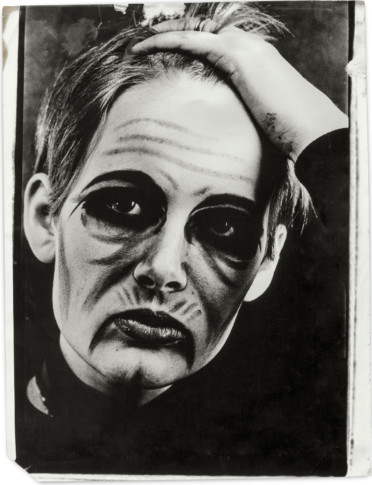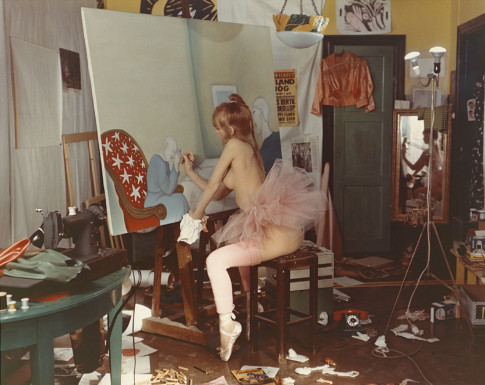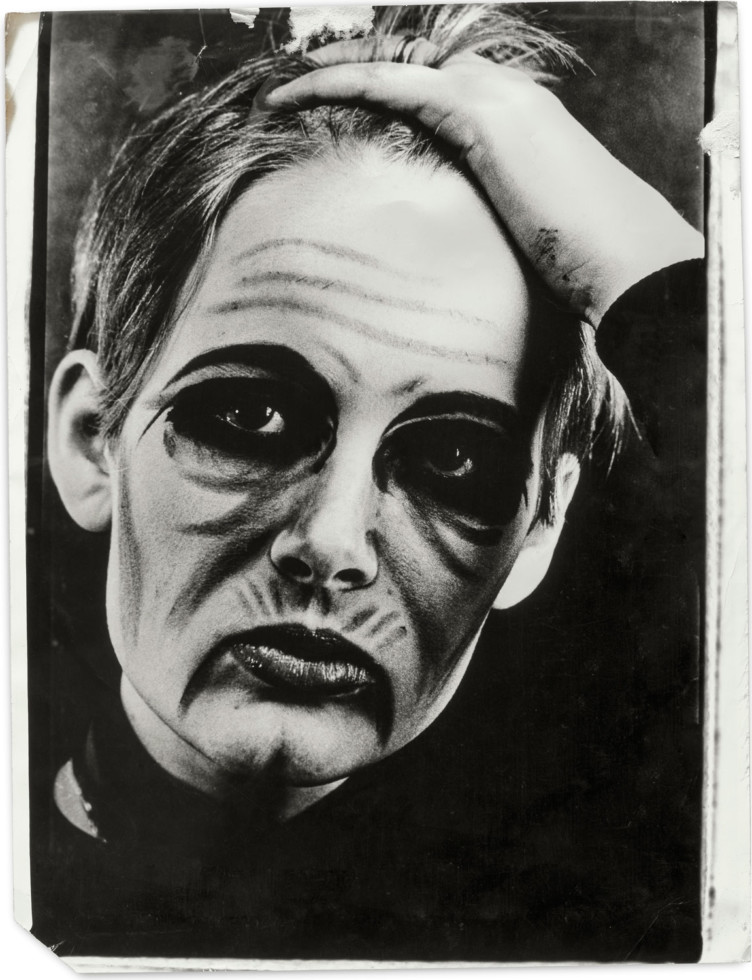
Marie-Louise Ekman, masked to look old, ca 1969 Photo: Carl Johan De Geer
Biography Marie-Louise Ekman
1944
Marie-Louise Fuchs is born on 5 November in Stockholm. Her parents are Maude Lönnqvist and Walter Fuchs. Her mother is a model and works in a fashion department store. Her father is an artist who, at the time of her birth, supports his family by painting movie posters for the big film studios.
1946
Her sister Madeleine is born.
1948
Her father has a son, Jan-Peter, with another woman.
1951
Starts school at Adolf Fredriks folkskola.
Her mother stays at home and her father periodically has a drinking problem. Her parents provide many traits of the characters that later on populate her oeuvre.
1952
Spends her summers with her sister Madeleine at summer camps between the age of eight and twelve.
1955
Studies life drawing at Stockholms Konstskola between the age of eleven and thirteen. The evening classes are led by the artist Allan Dollmén, who gives her valuable support.
Her father informs her of her unknown brother, who is seven and wants to meet her. They meet in secret.
Another four siblings are born in subsequent years in other relationships.
1956
Becomes a pupil at Mosebackeskolan, after a painful dispute with her class teacher at Adolf Fredriks folkskola.
1957
Fails her secondary-school exams at Enskilda gymnasiet.
1959–1961
Enrols at Östermalms kommunala flickskola (upper secondary school). Repeats her final year but fails in all subjects. Her father decides she should follow in his footsteps and become an artist. He himself has given up art, and is now working as PR manager at Vasateatern in Stockholm, and also does advertising for various films. Her mother has started working in a local shop selling coats.
Marie-Louise is accepted at the Åke Pernby School of Painting.
1960
Her parents separate.
Marie-Louise becomes interested in her father’s Jewish background and starts living as an Orthodox Jew in the household of her divorced mother and sister.
1962–1963
After she fails her studies at the school of painting, her father decides that Marie-Louise should study advertising at Anders Beckman’s college. She is expelled due to poor results, but is later allowed to transfer to the illustration course.
1964
Goes to a religious kibbutz in Israel, staying there for five months before ending her Jewish-Orthodox period.
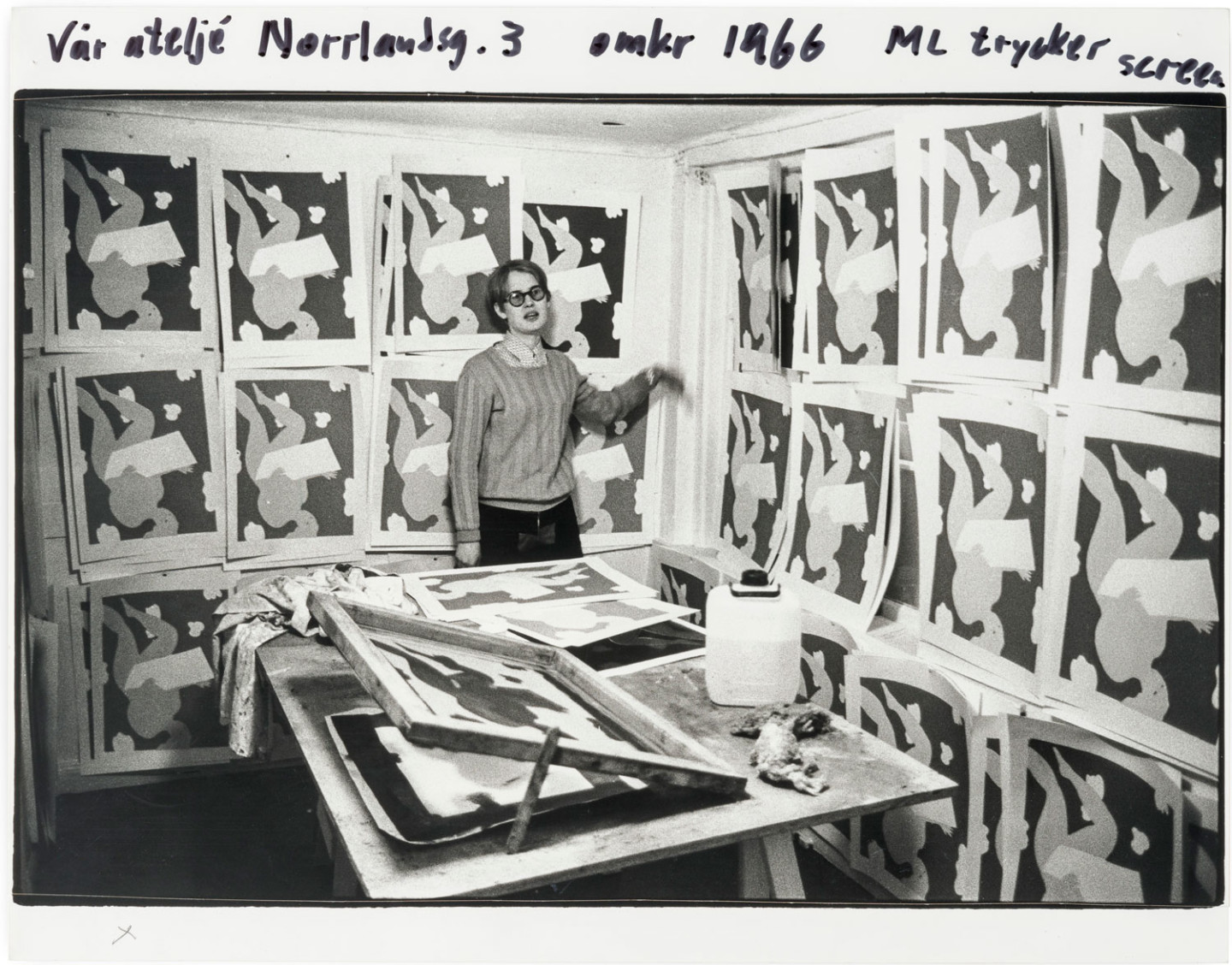
1966
Meets the artist and photographer Carl Johan De Geer at a student party at the Konstfack University College of Arts, Crafts and Design in Stockholm. Their home evolves into a three-dimensional notebook, with satin appliqué, animal masks, paintings, silkscreen prints, doll’s house interiors, textile prints, photo booths and black-and-white photographs.
They get married and begin working together.
1967
Her debut exhibition at Galleri Karlsson in Stockholm, together with Carl Johan De Geer. Both show graphic art and prints intended to make art available to everyone. Several of Carl Johan’s screen prints are confiscated by the police, and the exhibition causes a scandal.
The same year, the couple also exhibit at Lidköpings konsthall and at the Municipal Library in Bredäng.
Marie-Louise participates in the group exhibition Mikro at Galleri Hedenius in Stockholm.
She designs the costumes for Revyn, directed by Ernst Günther for the Stockholm City Theatre.
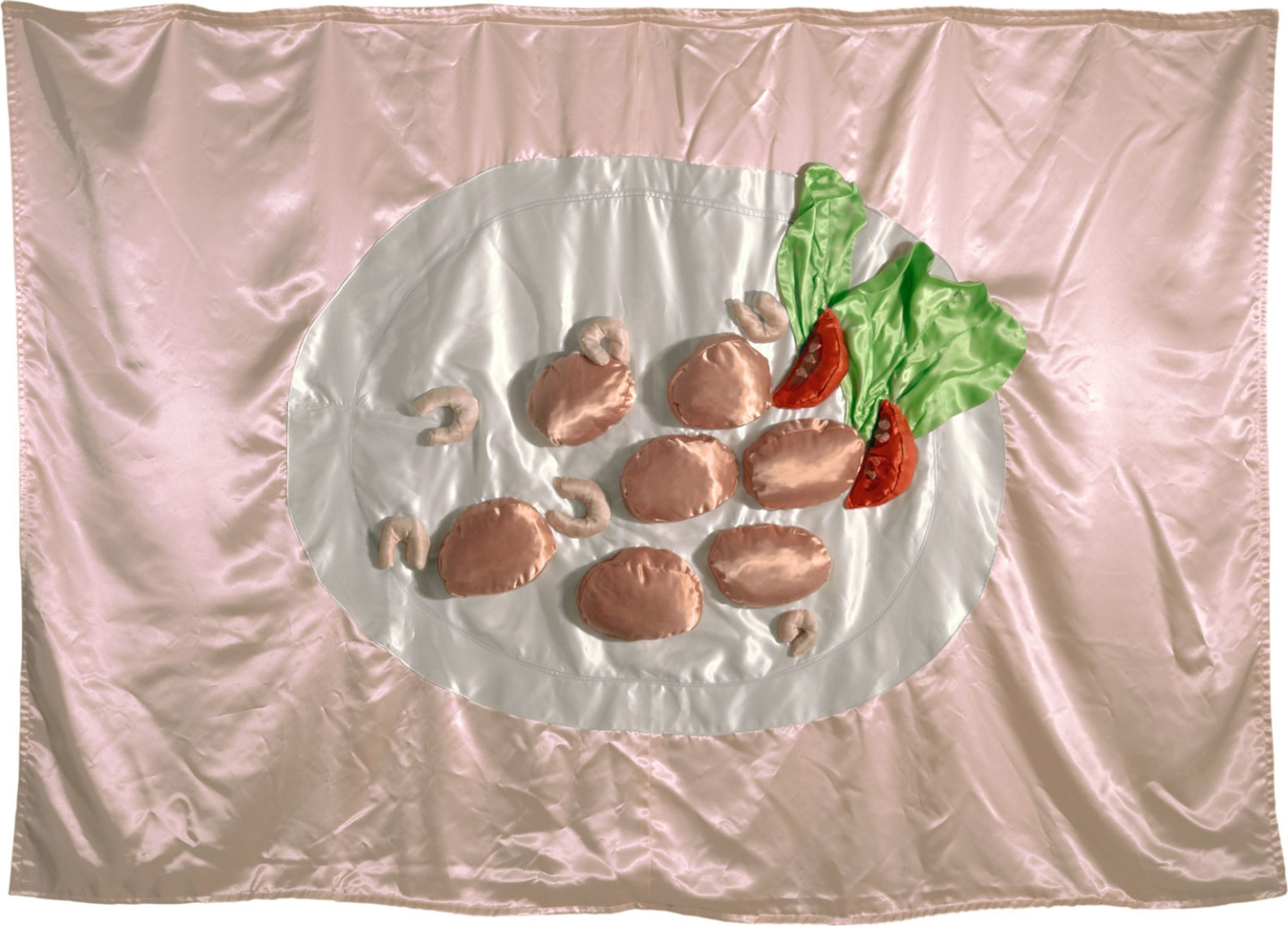
1968
At a new exhibition at Galleri Karlsson, the director of Moderna Museet buys the silk appliqué Fishcakes in Lobster Sauce (1968) for the collection.
Marie-Louise shows her acrylic glass boxes with scenes and relationships for the first time in an exhibition at Form Design Center in Stockholm.
She also exhibits at Galleri Lundensis at Krognoshuset in Lund and participates in the group show Konsten som agitator (Art as Agitator) at Södertälje konsthall.
Marie-Louise and Carl Johan De Geer move in the same circles as the editors of the underground magazine Puss, including Lars Hillersberg, Lena Svedberg, Ulf Rahmberg, Jan Hannerz, and Peter Wanger.
She and Carl Johan embark on a series of weekly magazine parodies for Puss.
1969
Plays one of the parts in Öyvind Fahlström’s film Provocation (1972).
Later, she co-founds the fringe theatre group Fria Teatern, with Torsten Wahlund, Birgitta Sundberg, Anders Linder, and others. Marie-Louise works as an actor, and the group performs in the streets and in prisons.
Takes part in the American psychologists Eberhard and Phyllis Kronhausen’s international exhibition Erotic Art at Liljevalchs konsthall, in Skulptur för blinda och seende (Sculpture for the Blind and the Sighted) at Moderna Museet, and in the Puss exhibition at Galleri Bellman, Swedish Touring Exhibitions and Gävle Museum.
In response to a survey in the art magazine Paletten (No 1) on the social and economic conditions for artists, she submits a nude centrefold of herself and describes painting as a hobby.
1970
On May Day, Marie-Louise and Carl Johan De Geer participate in Vilgot Sjöman’s talk show Öppen kamera in the recently launched TV channel TV2.
Marie-Louise has her first solo show at Svensk-Franska konstgalleriet in Stockholm, a pivotal event in her artistic career.
She is invited to exhibit in the canteen at Linköping Hospital, but her works are removed after one day by staff representatives, who are offended by the subject matter.
She appears at Stockholm City Theatre in the play Minns du den stad, directed by Johan Bergenstråhle, as the factory girl Ingeborg, who becomes an artist’s model, only to end up as a prostitute.
1971
Her solo show Till min älskade (To My Beloved) opens at Svensk-Franska konstgalleriet in Stockholm. It includes the painting Life and Death (1971), which explores the comic strip format. The painting distinctly features the artist’s characteristic way of portraying relationships, with sexual taboos and cracks in the idyllic façade of the nuclear family.
She participates in the group exhibition Glädje och sorg (Joy and Sorrow) at Vänersborgs museum in Trollhättan.
She co-authors the radio drama Två flickor i Paris (Two Girls in Paris), with Britt Edwall for Swedish Radio.
She marries the stage director Johan Bergenstråhle.
1972
Her solo exhibition Cheap Thrills in Helsinki includes paintings where pieces have been glued on, such as miniature toasters, skeletons, house plants, vacuum cleaners, framed objects, and newspaper cuttings.
She and Britt Edwall together make the radio programme Äckliga saker (Repulsive Things).
Her daughter Johanna is born.
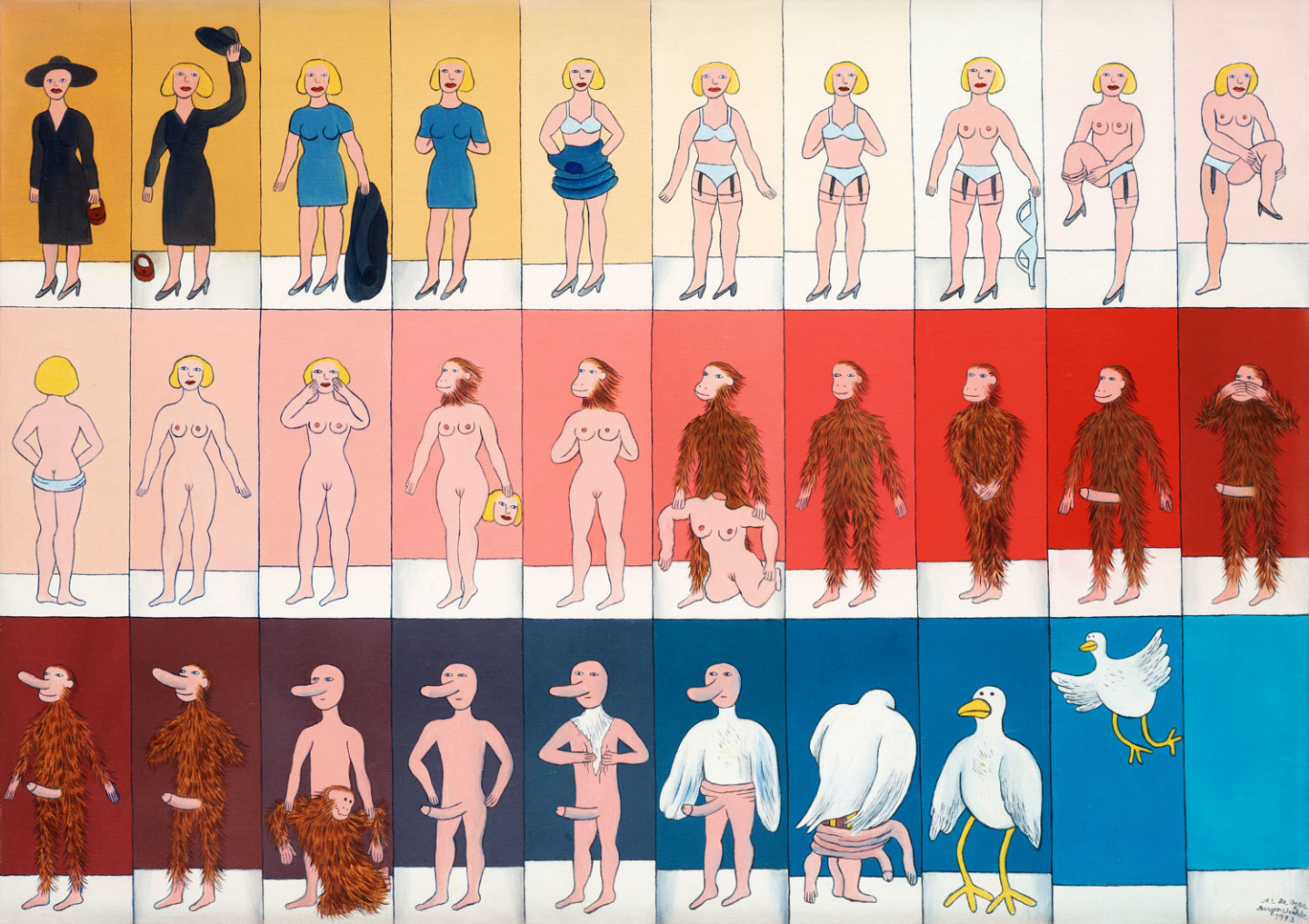
1973
Her solo show at Galleri Heland is an artistic and popular breakthrough.
The same year, she makes Striptease (1973), one of her most reviewed and reproduced paintings. It shows a “lady” (based on her mother, Maude) removing her clothes, transforming into a sexual, animal being, a man, and eventually a bird that flies off.
Created a tribute to Julia Pastrana in the series Ape Woman I–X (1973) and participates in the group show Fri Textil (Free Textile) at Lunds konsthall.
The left-wing bookstore Oktober denounces Marie-Louise De Geer Bergenstråhle’s art and stops selling her posters, including On the Toilet (Evening Trunk) (1969), stating that her posters condone bourgeoisie mass culture by not taking a clear political stand, and that they portray women as passive, unaware, and preoccupied with sexual fantasies.
She designs the costumes for Johan Bergenstråhle’s production of Gösta Berling’s Saga at the Stockholm City Theatre.
1974
A solo show at Galerie Bonnier in Geneva includes Playmate (1973), a book in pink satin and faux fur with a female pudendum inside. For the exhibition, Marie-Louise also sews a pink doll’s house, where painted figures unexpectedly come to life in the various rooms.
She participates in the group exhibitions A Head Museum for the Eighties at Moderna Museet, Dockskåp (Doll’s Houses) at Galleri Heland, and Collage for Swedish Touring Exhibitions.
1975
For a solo show at Galerie Bonnier during the Basel art fair, Marie-Louise designs an exhibition space in pink satin, with paintings of shadow ladies drawing, and encounters between children, adults and animals inside opened sardine tins.
She participates in the IX Biennale de Paris, with Marina Abramović, Valie Export, Lynda Benglis, Gordon Matta-Clark, and others.
She finishes a script for the experimental, autobiographical film Hallo Baby (1976), in which she plays the leading character. Johan Bergenstråhle directed, and Carl Johan De Geer designs the sets.
The same year, Marie-Louise also scripts and directs the film Sagan om den lilla, lilla flickan (Once Upon a Time There Was a Little Girl, 1978) for Swedish Television.
She designs the costumes for Herr von Hancken, (Mr von Hancken) directed by Johan Bergenstråhle, and the sets and costumes for Don Juan, directed by Jonas Cornell. Both plays are performed at the Stockholm City Theatre. Don Juan’s costume, featuring a wolf crotch and a Marilyn Monroe wig, cause widespread media attention.
Her daughter Lovisa is born.
1976
At a solo exhibition at Galleri Heland in Stockholm, she shows the works The Guests (1976) and The Party II (1976), acquired by Moderna Museet. Included are also several small dinner paintings with miniature people in the food, bell jars with tiny figures in various scenes (Fly Sofa [1976], The Sunbathers [1976], The Crime [1976]), and acrylic glass boxes with so-called everyday situations.
Later that year, Marie-Louise also has a solo exhibition at Norrköpings Konstmuseum, which features her paintings A Day in the Life (1973), and In the Jungle (1976).
She writes and directs the short film Mamma pappa barn (Mother Father Child, 1977), a wryly humorous kitchen sink drama about a girl fighting for more space in her family.
Exhibits at the Arte Fiera 76 in Bologna, and participates in the exhibition Porträtt (Portraits) at Galleriet in Lund, and Mikro at Galleri Lucifer in Skövde.
Is invited to show her work Untitled (1976) in the Schubladenmuseum (1970–77), also called the Museum of Drawers, a project by the Swiss artist Herbert Distel, who has transformed a tall chest into an art museum showing 500 miniature objects by 500 artists.
Embarks on a long collaboration with the choreographer and dancer Mats Ek, designing sets and costumes for the ballet St George and the Dragon, which Ek created for the Cullberg Ballet.
Does her first joint project with the actor Gösta Ekman, the satire programme Kabaré Öppen kanal for Swedish Radio.
1977
Solo show at Galerie ’t Venster in Rotterdam and at Galerie Bonnier in Geneva.
Participates in the group exhibition Inbound/Outbound at Zona in Florence.
The same year, Marie-Louise writes and illustrates the children’s book Sagan om den ensamma damen (The Tale of the Lonely Lady) for Rabén & Sjögren publishers.
She is appointed deputy professor at the Royal Institute of Art in Stockholm.
Hosts the very popular Swedish Radio programme Sommar i P1 for the first time, reading out loud the anonymous hate mail she had received. She begins the programme with the words “This is the piss rat speaking…”. The programme provokes outrage and a complaint is filed with the Parliamentary Ombudsmen.
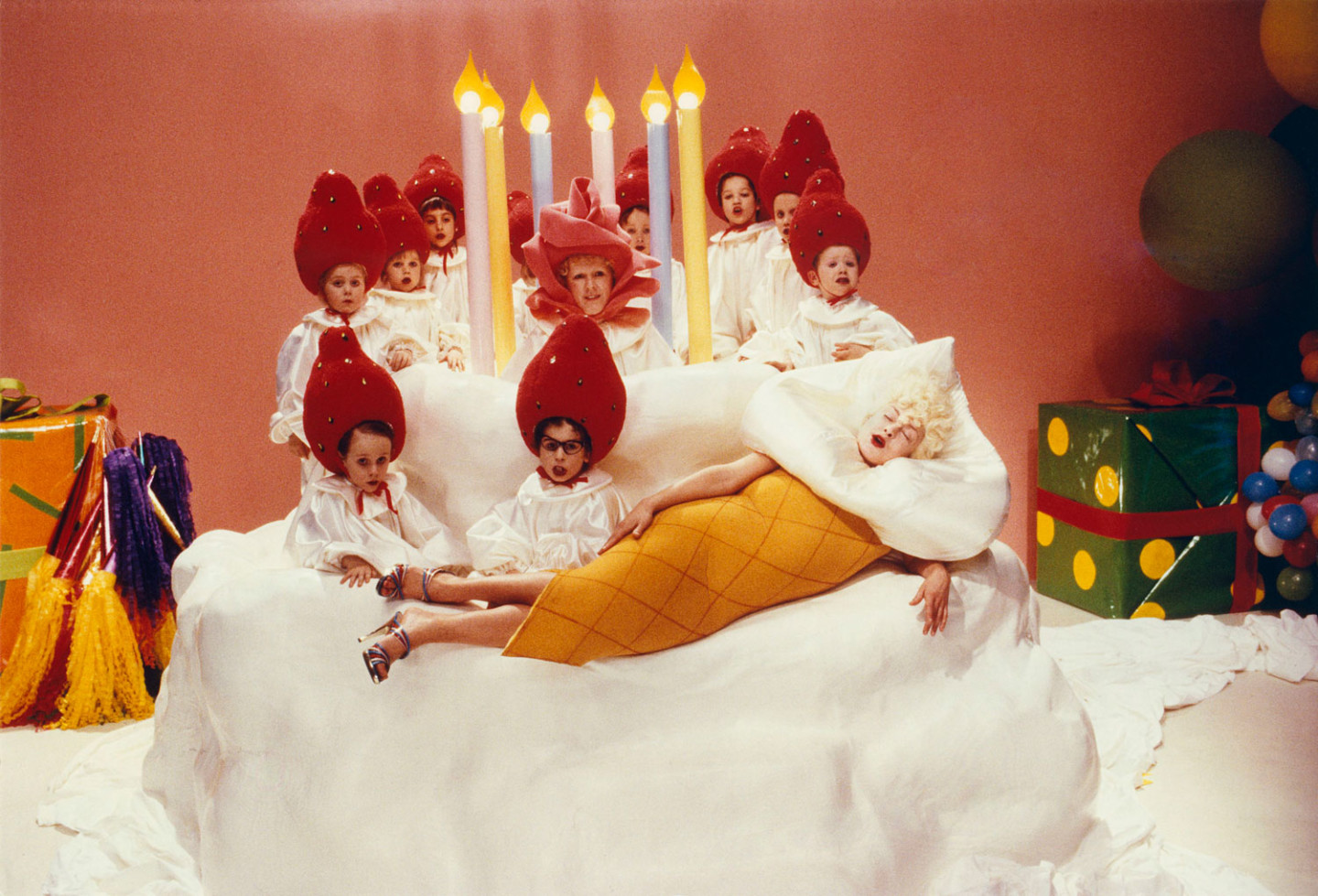
1978
Takes part in the touring exhibition Sverige i dag och i Östeuropa (Sweden Today and in East Europe), organised by the Swedish Institute.
She also participates in the group exhibition Kvinnokonst (Art by Women) in the parliament building in Stockholm.
Writes and directs the feature film Barnförbjudet (The Elephant Walk, 1979), an uncensored narrative from a child’s perspective about the everyday life of a girl, at nursery school and at home with her parents and grandmother. The press consider it provocative and wild.
Designs the sets and costumes for the ballets Bernarda’s House and The Four Seasons, both by Mats Ek, for the Cullberg Ballet.
1979
Participates in the group exhibitions Naturligtvis (Naturally) at Konstfack in Stockholm, Mikro at Galleri Wallner in Malmö, and at Galleri Octopus in Uppsala.
Designs sets and costumes for the ballet Antigone by Mats Ek for the Cullberg Ballet.
Wins the Chaplin Award for the film Barnförbjudet (The Elephant Walk).
The same year, she appears on the family talk show Hylands hörna on Swedish Television.
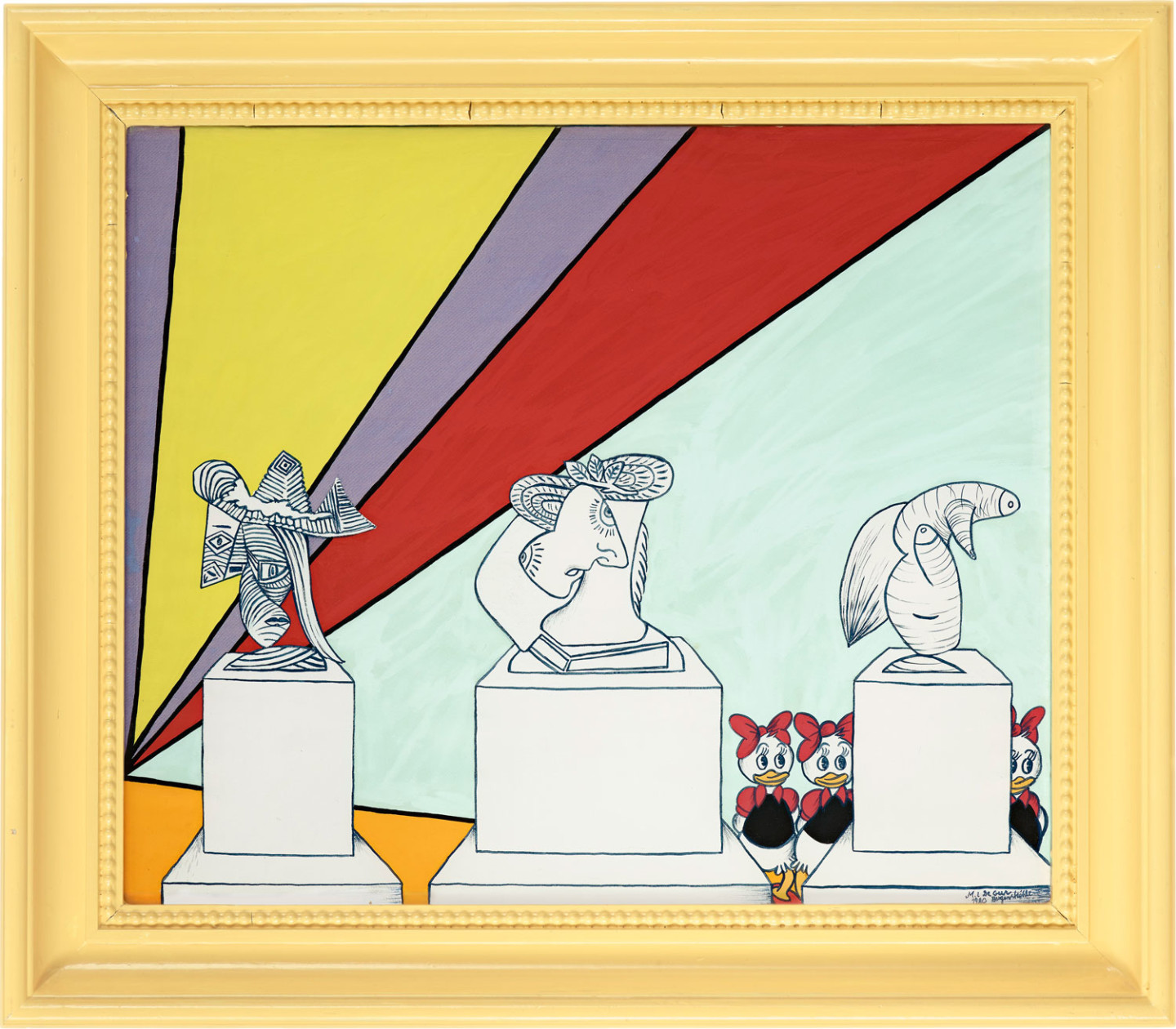
1980
At a solo show at Galerie Aronowitsch in Stockholm, Marie-Louise shows paintings where all the scenes are set in rooms that depict Olle Bærtling paintings, and mixing images culled from Salvador Dalí, Pablo Picasso, Walt Disney, and J. J. Grandville, with her own and her children’s experiences of divorce, interludes, and positions of strength and weakness. (A Split-Open Crocodile Monument and an Olle Baertling Painting [1980], The City’s Monuments and 21 Olle Baertling Paintings [1980]).
Participates in the exhibitions Silkscreen, New Prints and Spring Salon at Galleri Octopus in Uppsala, Petit parade at Galerie Bonnier in Geneva, 21 Meetings at Jönköping County Museum, and Mikro at Futura.
Embarks on a collaboration with film producer Kalle Boman and HB Hinden, later Hinden/Länna-Ateljéerna AB, that goes on for many years.
1981
In the solo show at Galleriet (Anders Tornberg Gallery) in Lund, Marie-Louise’s exhibited works include paintings with shapes that fragment or crack.
She takes part in the exhibitions Spelets regler/Pelihenki (The Rules of the Game) at Amos Andersons konstmuseum in Helsinki, Vårdträdet at Kulturhuset in Stockholm, Kropp och kläder (Body and Clothes) at Göteborgs Konstmuseum, The Seventh British International Print Biennale in London, and in exhibitions at Galerie Aronowitsch in Stockholm and A.I.R. Gallery in New York.
Writes and directs the short film Sagan om den lilla flickan och den stora kärleken (The Little Girl and the Big Love, 1986) for HB Hinden.
Writes and directs the radio drama Den falska människan (The False Human), starring Georg Rydeberg and Sune Mangs.
The Uffizi Gallery in Florence, one of the oldest art museums in the world, commissions the artist to make a selfportrait for its portrait gallery.
1982
Writes and directs the film Moderna människor (Modern People, 1983) for Hinden/Länna-Ateljéerna AB. Set in the home of a single mother, whose unhappy sister, troubled by love, interrupts her Christmas Eve preparations. The part of the single mother was played by Annikka Nuora.
Solo show at Galerie Bonnier in Geneva, where she shows works inspired by Salvador Dalí, Piet Mondrian and Giorgio de Chirico (Mystery and Melancholy of a Street [1982], Composition V [1982]).
Participates in exhibitions at Galeria Studio and the Culture Palace in Warsaw.
Writes and directs the radio drama Den falska människan del II eller Den skrattande bögen (The False Human Part II or The Laughing Queer) for Swedish Radio.
Designs sets and costumes for Mats Ek’s ballet versions of Cain and Abel for the Royal Opera in Stockholm and Giselle for the Cullberg Ballet.
1983
Writes and directs the film Stilleben (Still Life, 1985) for Hinden/Länna-Ateljéerna AB, in which a few men and children gather on a Rococo veranda to play a game together. The game grows serious, and parts of the dialogue are in nonsense language.
Writes and directs the radio drama Den falska människan del III (The False Human Part III) for Swedish Radio.
Designs sets and costumes for Mats Ek’s ballet Cain and Abel for the Opera in Helsinki.
Her painting Striptease (1973) is turned into an animation by the Swedish Film Institute.
1984
Participates in the exhibition Vive l’enfant at the Swedish Institute, Centre Culturel Suédois in Paris.
The Ministry of Culture appoints Marie-Louise professor of painting at the Royal Institute of Art in Stockholm – she is its first female professor, and the first woman to be on the regular teaching staff.
Designs sets and costumes for Mats Ek’s ballet Rites of Spring for the Cullberg Ballet.
1985
Wins the Nordic Radio Prize for best new radio drama. The jury states that Den falska människan del III (The False Human Part III) delivers “a penetrating portrait of an aging artist’s struggle with existential anxiety and loneliness”.
Participates in an exhibition of Swedish prints at Centro de Arte y Comunicación in Buenos Aires.
1986
Writes and directs the film Fadern, Sonen och Den Helige Ande (The Father, the Son and the Holy Ghost, 1987) for Hinden/Länna-Ateljéerna AB. This is the story of a father, his son, his son’s girlfriend, and a neighbour, on a seemingly ordinary evening in Stockholm.
Launches a project for the arts section in Aftonbladet, which consists of publishing her illustrated poems for several years. The poems concern current politics, private thoughts and portraits of people. (“Människor jag äger”, “Avföringsdag I–VII”, “Inspelningsledaren Brita Werkmäster”, “Information till den del av befolkningen som aldrig blir intervjuad” [People I Own, Excrement Day I–VII, Recording Manager Brita Werkmäster, Information to the Part of the Population Who Never Get Interviewed])
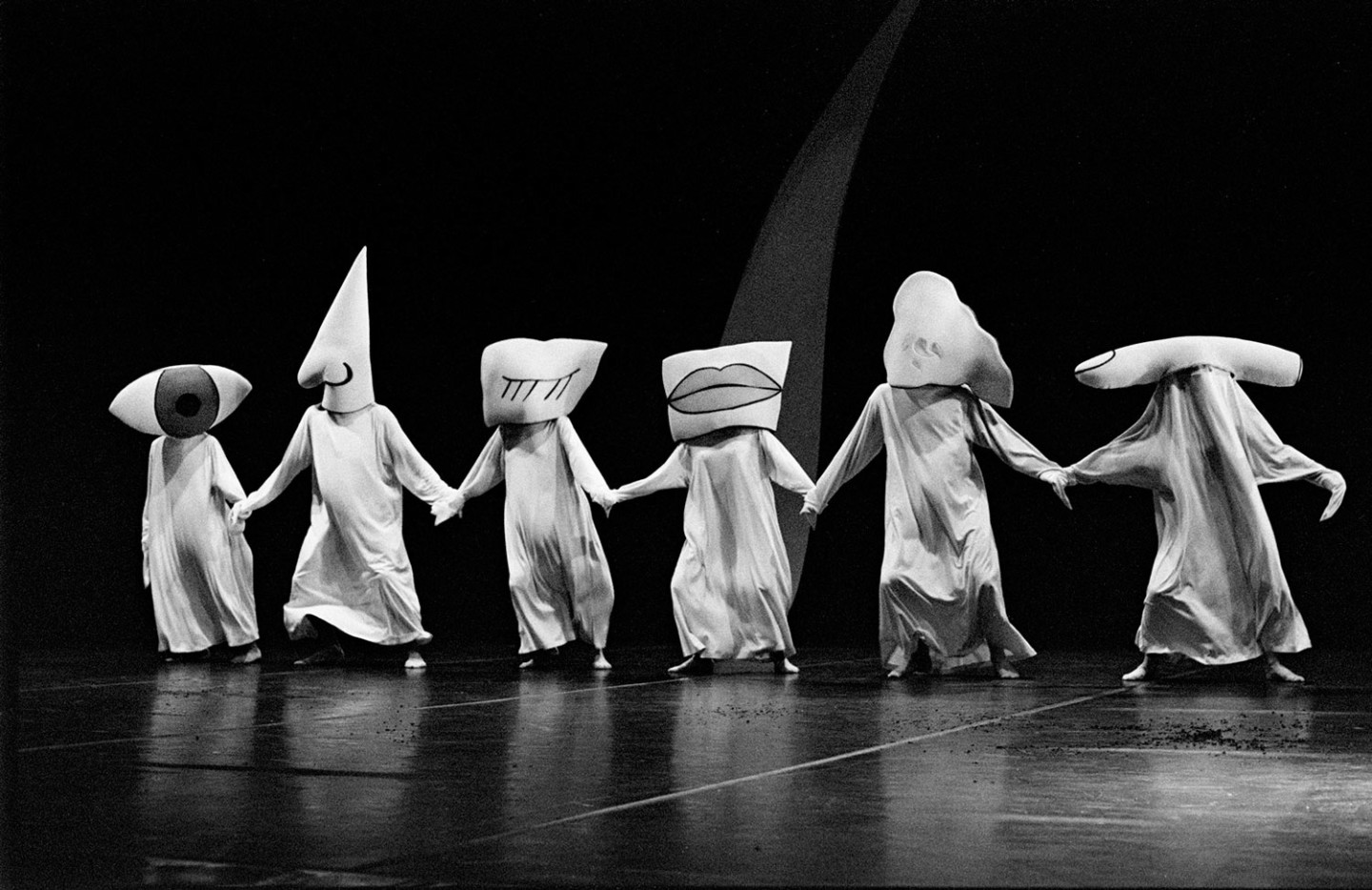
1987
Designs the sets and costumes for the ballets The Park and Swan Lake, both by Mats Ek, for the Cullberg Ballet.
Hosts the radio programme Sommar i P1 for the second time.
1988
Writes and directs the film Delirium (not yet screened) in collaboration with Hinden/Länna-Ateljéerna AB.
Writes and directs a TV series, Målarskolan (The Art School, 1990), produced by Hinden/Länna-Ateljéerna AB. The series of ten episodes, broadcast by Swedish Television, is about life at an art school, where the students are trying to find themselves and their artistic practices. The leading character, Figor Mandelstam, is a constant source of irritation due to his enormous desire to please.
Also writes and directs the radio drama Den första kvinnliga statsministerns tal till nationen (The First Female Prime Minister’s Speech to the Nation) for Swedish Radio. The prime minister is played by Margaretha Krook.
In Aftonbladet Marie-Louise publishes a text in which she herself poses as the Swedish minister of culture.
Designs sets and costumes for Mats Ek’s ballet Like Antigone at the Stuttgarter Ballett in Stuttgart.
1989
Writes and directs the film Den hemliga vännen (The Secret Friend, 1990) for Paris Förlag/Hinden/Länna-Ateljéerna AB. The film is about a few friends fighting with each other in an apartment for a day where it seems that anything could happen. Who is sick and who is healthy, and who is in love with whom? Den hemliga vännen is Sweden’s official entry for the Festival de Cinéma Européen de la Baule in France.
Marries Gösta Ekman.
Becomes mother to Billie and Robin.
1990
Designs the sets and costumes for the first performance of Mats Ek’s ballet Over There for Nederlands Dans Theater in The Hague.
1991
A retrospective exhibition of Marie-Louise Ekman’s works opens at the Swedish Institute, Centre Culturel Suédois in Paris.
Writes and directs the TV series Duo jag (You and Me) with Gösta Ekman for Swedish Television.
At her own request, she leaves her post as professor of painting at the Royal Institute of Art, due to “fear of repetition”.
1992
Participates in the Swedish pavilion at the international Expo ’92 exhibition in Seville, showing an iron sculpture, Det svenska tungsinnet (Swedish Gloom, 1992), which depicts a man in a beret crying. Gösta Ekman modelled for the sculpture, which was made in collaboration with the artist Heinrich Müllner and students at the Royal Institute of Art in Stockholm.
Writes and directs the TV series Vennerman & Winge with Gösta Ekman for Swedish Television.
Designs sets and costumes for Carmen by Mats Ek for the Cullberg Ballet.
Designs four new postage stamps for the Swedish postal service.
1993
Solo exhibition at Musée d’art moderne et contemporain in Geneva, where she also takes part in the exhibition Caléidoscope suédois at Galerie Bonnier.
Cinémathèque suisse and Fonction: Cinéma organises a three-day film programme featuring her films.
Appointed board member of the Swedish Arts Council (1993–1996) and chairman of KLYS, the Swedish Joint Committee for Artistic and Literary Professionals (1993–1995).
Writes and directs the play I fru Vennermans fall (In Mrs Vennerman’s Case) together with Gösta Ekman for Teater Kilen at Kulturhuset in Stockholm.
Creates a music video for the musician Josefin Nilsson, High Hopes and Heartaches, with lyrics and score by Björn Ulvaeus and Benny Andersson.
Designs sets and costumes for the ballet Giselle by Mats Ek for Opéra national de Paris.
Her father Walter Fuchs dies.
Her granddaughter Elsa is born.
1994
Solo show at Galleri Engman in Umeå, presenting texts and illustrations from her collaboration with the arts section in Aftonbladet. Designs sets and costumes for Carmen by Mats Ek for Teatr Wielki–Opera Narodowa in Warsaw.
1995
Johan Bergenstråhle dies.
1996
Writes the script for Nu är pappa trött igen (Dad is Tired Again), which she co-directs with Gösta Ekman, who also plays the lead.
Designs sets and costumes for the ballet Giselle by Mats Ek for Bayerisches Staatsballett in Munich.
1997
Designs sets and costumes for the ballet Giselle for La Scala in Milan.
1998
A major retrospective exhibition at Kulturhuset in Stockholm, curated by Maria Lind. The exhibition tours Sweden for a year. Also participates in the group exhibition Come Closer – 90s Art from Scandinavia and its Predecessors at Kunstmuseum Liechtenstein, Vaduz, and Ludwig Múzeum in Budapest.
Writes the play God natt herr Morris (Good Night, Mr Morris), and dedicates it to Gösta Ekman, who performs it at Teater Kilen in Stockholm, before it goes on tour in Sweden for a year.
Designs sets and costumes for Johanna by Mats Ek at Orionteatern in Stockholm.
1999
Appointed vice chancellor of the Royal Institute of Art in Stockholm, the first woman to hold that position.
Solo exhibition at Galerie Aronowitsch in Stockholm.
Participates in the exhibitions En oskriven historia (An Unwritten History) at the Royal Armoury, and Århundradenas konstverk (Artworks of the Centuries) at the Nationalmuseum, both in Stockholm.
The film Figor Mandelstam på museum (Figor Mandelstam at the Museum) is filmed at the Nationalmuseum, Moderna Museet and the Royal Institute of Art. It is produced by Hinden/Länna-Ateljéerna AB.
Designs sets and costumes for the ballet Giselle by Mats Ek for Göteborgsoperan.
2000
Writes the script for the film Puder (Powder, 2001), and co-directs it with Gösta Ekman, for Hinden/Länna-Ateljéerna AB. The film is about a day at the theatre Teater Krokodil.
Solo exhibition at Galleri Arnstedt & Kullgren in Östra Karup.
Participates in the exhibitions Norden at Kunsthalle in Vienna, and Ätbart (Edible) at the Nationalmuseum in Stockholm.
Cinemateket in Stockholm organises a retrospective exhibition.
2001
Writes and directs the radio drama Uppståndelsen (The Resurrection) for Swedish Radio. The cast includes Margaretha Krook, Keve Hjelm, Gösta Ekman, Jonas Karlsson, Lena Nilsson and Cecilia Frode.
2002
On her own initiative, sculpts a statue of Margaretha Krook with the artist Heinrich Müllner and students at the Royal Institute of Art in Stockholm. The statue, which is heated to body temperature, is installed on the corner of the Royal Dramatic Theatre where Margaretha Krook used to stand smoking.
Writes the script for the film Asta Nilssons sällskap (Asta Nilsson’s Company, 2005), and co-directs it with Gösta Ekman, for Hinden/Länna-Ateljéerna AB.
Solo exhibitions at Malmö Konstmuseum and Kulturhuset in Stockholm.
Kulturhuset shows her glass sculptures of injured birds and children.
Designs sets and costumes for two productions of the ballet Carmen by Mats Ek for Opéra national de Lyon and the Royal Opera in London.
2003
Solo exhibition at Konsthallen Lokstallet in Strömstad.
2004
Shows glass sculptures at the exhibition The Venetian Pharmacy in a former pharmacy in Venice. The works include sick birds and children, injured fingers, flowers and dog bones made of glass wrapped in bandages.
The sculpture Det svenska tungsinnet (Swedish Gloom) is installed permanently in the Altona park in Malmö.
2005
Designs sets and costumes for Carmen by Mats Ek for Staatstheater Hannover, and for the ballet Bernarda’s House by Mats Ek for Deutsche Opera am Rhein in Dusseldorf.
2006
Exhibition at Malmö Konstmuseum, together with the artist Bjarne Melgaard.
2007
Together with the artist Heinrich Müllner and students at the Royal Institute of Art in Stockholm, she creates a bronze statue of Astrid Lindgren writing in her study. The chair next to her in which people can sit is warm. The statue is installed in Vimmerby town square.
The play Gäckanden (The Mocking) opens at the Royal Dramatic Theatre’s small stage in Stockholm. Written by Marie-Louise and co-directed with her husband, Gösta Ekman. The sets are designed by Peder Freiij. The play is the first part of a planned trilogy about her mother’s aging, and describes the isolated life in her apartment, which is haunted by unknown forces. Marie Göranzon played the mother. The cast also includes Gunilla Nyroos, Inga-Lill Andersson and Suzanna Dilber.
Designs sets and costumes for the opera Orphée by Mats Ek for the Royal Opera in Stockholm.
2008
Solo exhibition at Angelika Knäpper Gallery in Stockholm.
Designs sets and costumes for the ballet Carmen by Mats Ek at the National Theatre in Prague, and for his ballet Bernarda’s House at Opéra national de Paris.
2009
Appointed artistic director and managing director of the Royal Dramatic Theatre (Dramaten) in Stockholm.
Films a Christmas Calendar for the Theatre’s website with her mobile camera.
Her mother Maude Fuchs dies.
2011
Participates in the exhibition Glasstress, organised by Berengo Studio/Venice Projects at Millesgården in Stockholm, showing her glass sculptures made by master glass blowers on the Venetian island of Murano.
2012
Participates in the exhibition Doing What You Want: Marie-Louise Ekman accompanied by Sister Corita Kent, Mladen Stilinović and Martha Wilson, at Tensta konsthall, and at Henie Onstad Kunstsenter in Oslo.
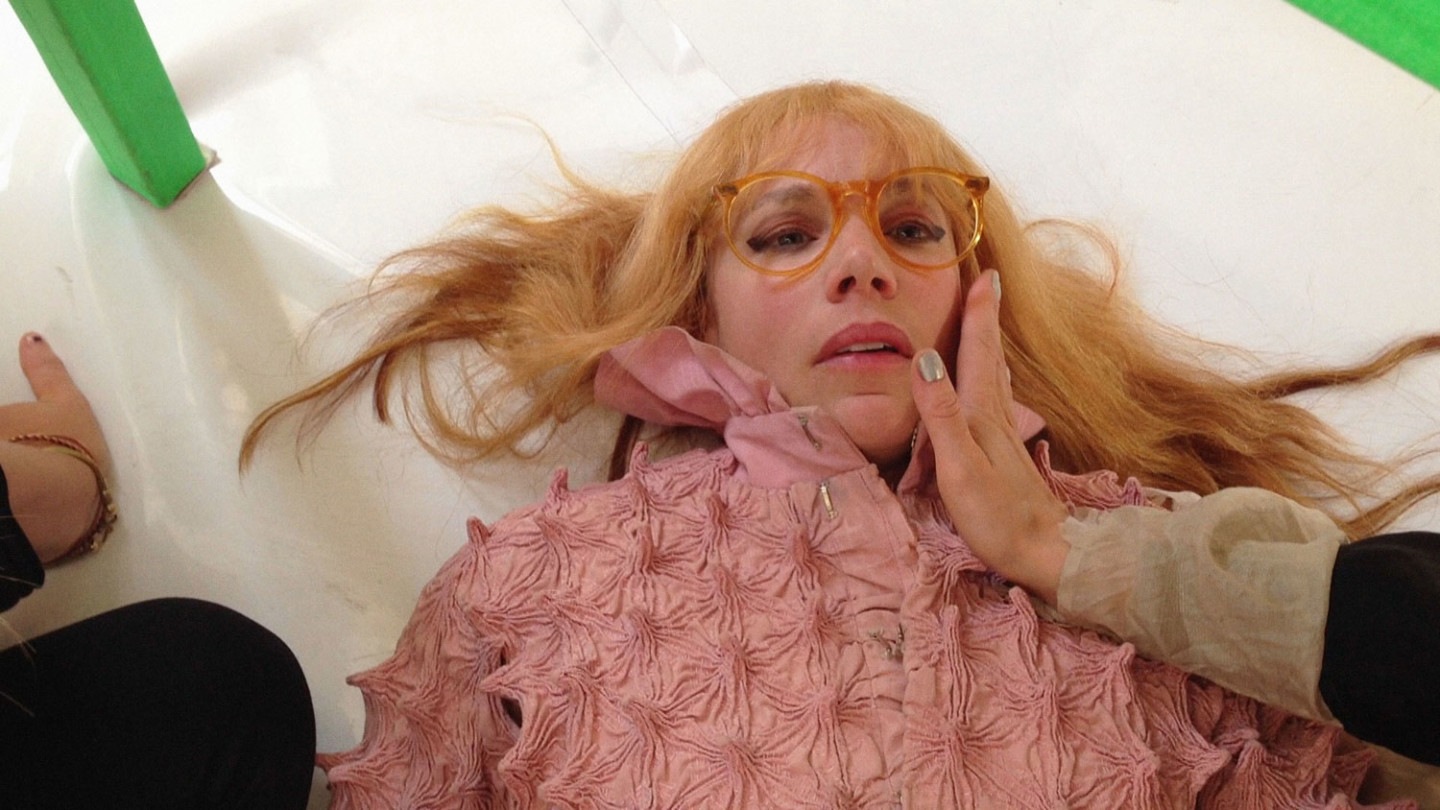
Bildupphovsrätt 2017
2013
Makes the web TV series Den dramatiska asylen (The Dramatic Asylum) for the Theatre’s website. Based on the actors and other staff at the Royal Dramatic Theatre, the 50 episodes (nearly five hours of film) portray the encounters and feelings that occur in the workplace. The narrative is largely set in the director’s office, and the theatre director, Marie-Louise herself, is played by five different actors: Marie Göranzon, Ingela Olsson, Stina Ekblad, Melinda Kinnaman and Ellen Jelinek.
Grafikens Hus in Mariefred hosts a solo exhibition produced by Tensta konsthall, featuring her prints. Folkets Hus och Parker organises a tour of the exhibition.
Gävle konstcentrum features a solo exhibition in association with Hinden/Länna-Ateljéerna AB and Tensta konsthall. The exhibition is also shown at Skellefteå konsthall in 2014 and Bohusläns museum in 2016.
2014
Her play Dödspatrullen (Death Squad), which she directed and designed the sets for, is produced at the Royal Dramatic Theatre’s small stage, as an independent sequel to Gäckanden (The Mocking). The narrative is about her mother’s move to an old people’s home, and her attempts to keep her strength up. The mother is again played by Marie Göranzon, while Örjan Ramberg plays her gentleman friend and neighbour Kurt Svalsjö.
She then resigns as managing director of the Royal Dramatic Theatre.
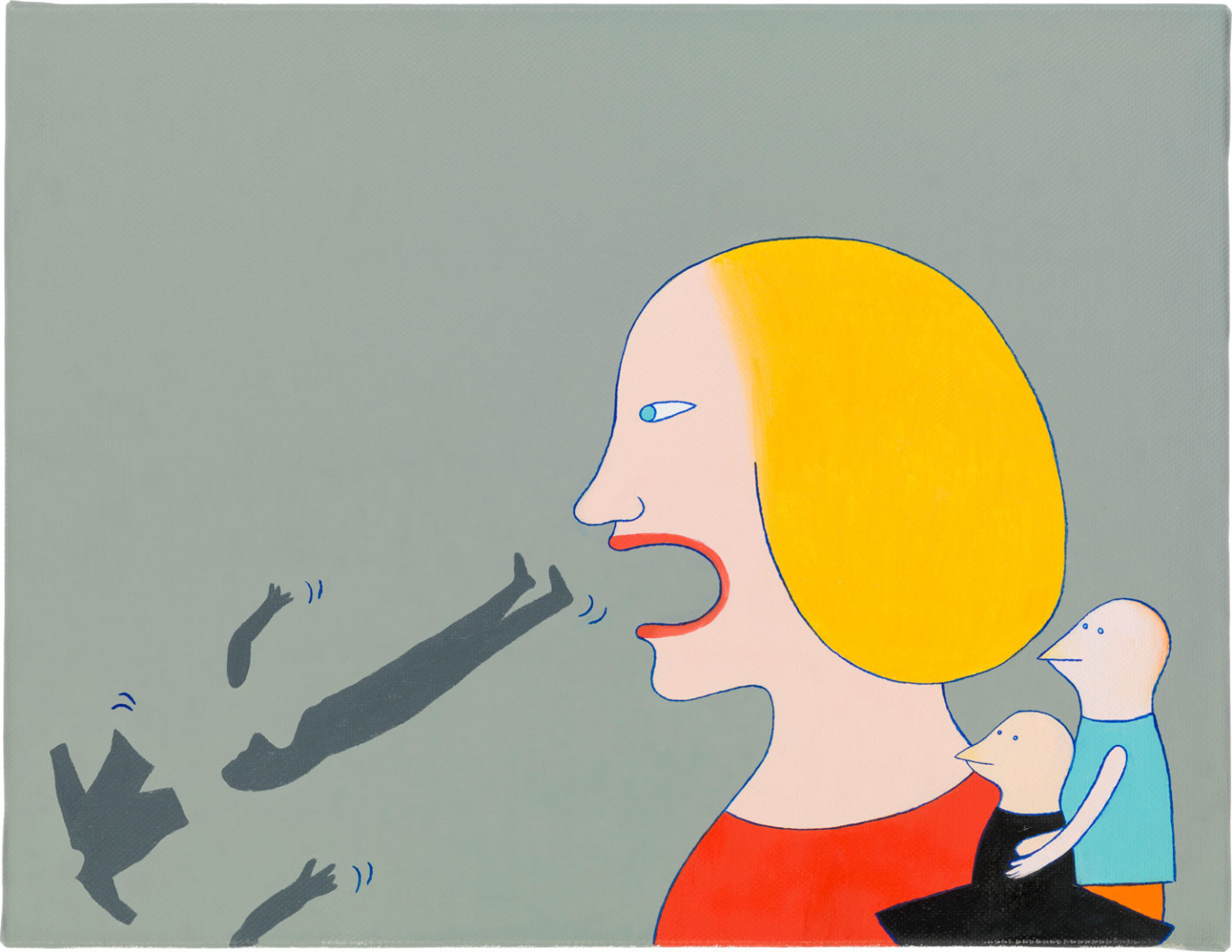
2015
Participates in the art festivals Survival K(n)it 7, organised by the Latvian Centre for Contemporary Art in Riga, and the IHME–Contemporary Art Festival in Helsinki.
She is also featured in the group exhibition Unorthodox, curated by Jens Hoffmann at the Jewish Museum in New York.
Embarks on a new period of studio painting, revisiting old motifs with her grandchildren Johan and Rebecka as her muses.
2016
Participates in the exhibitions Seek Professional Help at the Bureau in New York, and Hamlet at Künstlerhaus Stuttgart, curated by Annika Eriksson and Fatima Hellberg.
Her works are shown in South Korea at the 11th Gwangju Biennale: The Eighth Climate (What Does Art Do?).
2017
Her radio drama En krumelur helst i första akten (A Squiggle, Please, in the First Act) is played for the first time in Swedish Radio. It was written for Jan Malmsjö and is about aging and the invisibility that then occurs. The cast includes Marie Göranzon, Hans Klinga, Kristina Törnqvist , Gunilla Nyroos, Sanna Sundqvist, Emma Mehonic and Ellen Jelinek.
Försökskaninerna (The Guinea Pigs), is the final part of the trilogy about her mother’s aging. It is performed in spring 2017 at the Royal Dramatic Theatre. This is a dream play about the move to a home for people with dementia, what happens in reality and inside her mother’s mind. Mother is played by Marie Göranzon, Father by Örjan Ramberg, and the Daughters by Ellen Jelinek and Julia Dufvenius. The cast also includes Kristina Törnqvist and Rolf Skoglund. Music by Benny Andersson.
The solo exhibition Marie-Louise Ekman opens at Moderna Museet in Stockholm.

